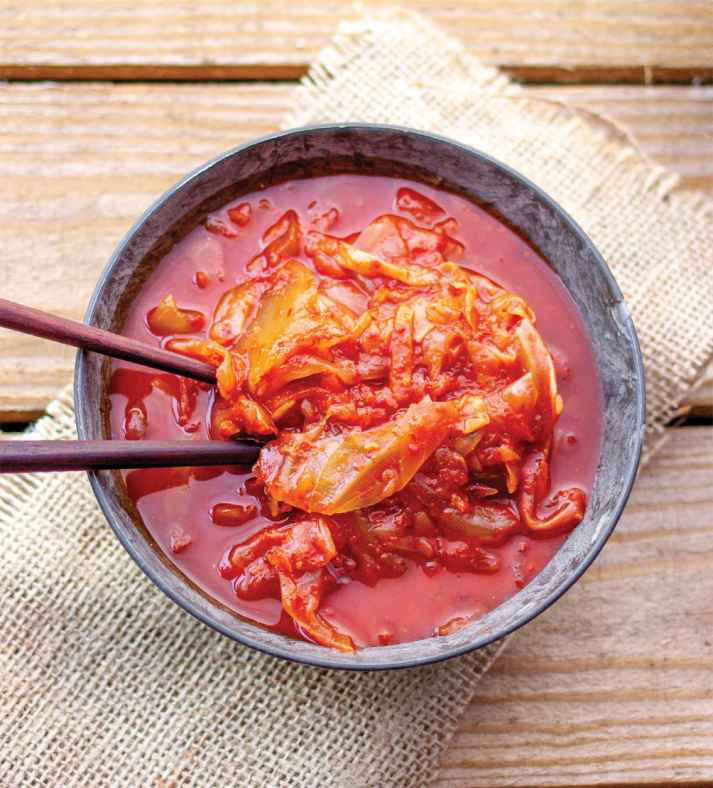Yield: 6 cups (½ cup per serving) Prep time: 25 minutes, plus up to 10 days to ferment image
Here are some helpful tips before you start:
• See the first three tips for making sauerkraut on here. The same tips apply here: use the right type of water (nonchlorinated) and the right type of salt (free of iodine or anticaking agents) and be scrupulously clean.
• Food-safe gloves are optional but highly recommended to protect your hands from stains or stings when mixing the spicy paste into the veggies.
• Fish sauce delivers an umami taste to kimchi. In lieu of fish sauce, you could use salted shrimp paste or a combination of both.
1 large head Chinese (napa) cabbage (about 2 pounds)
¼ cup fine sea salt
Nonchlorinated water, such as filtered, spring, or distilled water
5 cloves garlic, minced
1 teaspoon grated fresh ginger
1 or 2 drops of stevia glycerite (optional)
2 tablespoons fish sauce
2 tablespoons Korean red pepper flakes, or more to desired heat (see Note)
8 ounces daikon radish, peeled and cut into matchsticks
4 green onions, trimmed and cut into 1-inch pieces
- Cut the cabbage lengthwise into quarters and remove the core. Slice each quarter crosswise into 1½-inch-wide strips.
- Place the cabbage strips in a large glass bowl and cover with the salt. Using very clean hands, massage the salt into the cabbage until it starts to wilt. Add water to cover the cabbage. Put a plate on top and weight it down with something heavy so the cabbage strips are submerged. Let sit for 1 to 2 hours.
- Transfer the cabbage to a colander and rinse very well with cold water. Drain for 15 minutes. Meanwhile, rinse and dry the bowl in which the cabbage strips were salted.
- In a small bowl, combine the garlic, ginger, stevia, if using, and fish sauce. Mash until you have a very smooth paste. Add 2 tablespoons of the red pepper flakes, or use more if you like a hotter kimchi.
- Using your hands, lightly squeeze the water from the cabbage strips and return them to the dry bowl. Add the radish, green onions, and paste.
- Wearing food-safe gloves or using clean hands, gently work the paste into the vegetables until they’re well coated.
- Stuff the kimchi into two sterile 1-quart wide-mouth mason jars, packing it in tightly. At this point you want to keep it submerged in the liquid. I place a very clean metal measuring cup in the mouth of the mason jar and weight it down with clean rocks (from our rock polisher).
- Place a cheesecloth or other clean thin cloth over the mouth of the jar and tie it with a string so air can flow in but the kimchi stays clean.
- During the next day or two, the kimchi will continue to release liquid. Press the measuring cup into the mixture every few hours to make sure the vegetables remain submerged.
- Now the fermenting begins. This takes 3 to 10 days. Keep the jars in a cool, dark room (65°F to 75°F), away from sunlight. Check it every day and press the kimchi down if it’s floating above the liquid.
- After 3 days, taste your creation. When it tastes good to you, remove the cheesecloth and object you used to weight down the cabbage. Seal with an airtight cover and store in the refrigerator. If you prefer a stronger fermented taste, keep fermenting until you have your desired taste. You may notice bubbles and cloudiness in your kimchi during fermenting. This is the good bacteria you want for a healthy gut flora.
- Store in the refrigerator for up to 2 months.
Note:
You can find Korean red pepper flakes at specialty stores or online. They provide a traditional Korean flavor that makes this dish extra special. They have a very bright red color and can range from mild to very hot. The mild version is referred to deolmaewoon gochugaru; the hot version is referred to as maewoon gochugaru.









